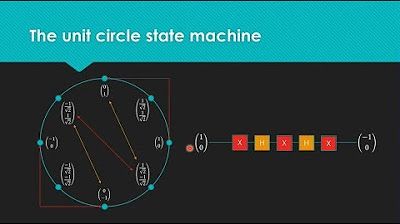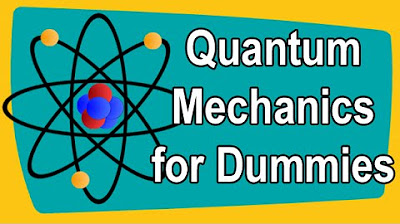What is Schrödinger's Cat? | Neil deGrasse Tyson Explains...
TLDRThe transcript explores the intriguing concepts of quantum physics, highlighting the famous thought experiment of Schrödinger's cat, which illustrates the principle of superposition and the observer effect. It humorously delves into the idea of consciousness affecting the physical world and touches on the historical significance of the 1920s in physics. The discussion also draws a parallel to modern applications in quantum computing, emphasizing the probabilistic nature of quantum bits or qubits, and their potential for enhanced computational power.
Takeaways
- 🌟 The concept of Schrödinger's cat is a thought experiment in quantum physics that illustrates the principle of superposition, where a particle can exist in multiple states simultaneously until observed.
- 😺 The reference to Schrödinger's cat is widespread in popular culture, often used in jokes and discussions despite many not fully understanding its scientific meaning.
- 🏆 Schrödinger was a renowned physicist, known for his contributions to the understanding of quantum mechanics, which studies the behavior of particles at a microscopic level.
- 👀 The 'observer effect' in quantum physics refers to changes that the act of observation will make on a phenomenon, which is sometimes misunderstood as relating to consciousness.
- 💡 Light carries energy, and its interaction with particles can lead to changes in their state, such as moving from one location to another when hit by a photon.
- 🌍 The concept of albedo, or the reflectivity of a surface, is important for understanding the Earth's climate, as it influences how much sunlight is absorbed versus reflected back into space.
- 🧪 Quantum computing leverages the principles of quantum physics, such as superposition and entanglement, to perform computations that are beyond the capabilities of classical computers.
- 🔢 In quantum computing, a qubit can exist in various states between 0 and 1, offering more computational versatility compared to classical bits which can only be 0 or 1.
- 🕳️ The phenomenon of quantum tunneling allows particles to move through barriers, an effect that is not fully understood but has significant implications for quantum physics.
- 🌌 The 1920s was a pivotal decade for physics, with groundbreaking discoveries in quantum mechanics and the realization that the universe is expanding, laying the foundation for modern scientific understanding.
- 📚 The complexity of quantum physics requires advanced mathematical calculations, which were performed by hand before the advent of calculating devices like Texas Instruments' early calculators.
Q & A
What is the Schrödinger's cat thought experiment?
-Schrödinger's cat is a thought experiment in quantum physics that illustrates the concept of superposition. It involves placing a cat in a sealed box with a radioactive atom, a detector, and a deadly poison. If the atom decays, the detector triggers the release of the poison, which would kill the cat. Until the box is opened and the cat is observed, the cat is considered to be simultaneously alive and dead, highlighting the probabilistic nature of quantum states.
What is the observer effect in quantum physics?
-The observer effect refers to the phenomenon in quantum physics where the act of observing or measuring a quantum system can change its state. It suggests that the observer's interaction with the system influences the outcome, emphasizing the importance of measurement in determining the state of a quantum system.
How does the concept of quantum superposition relate to the observer effect?
-Quantum superposition is the idea that a quantum system can exist in multiple states simultaneously until it is observed or measured. The observer effect demonstrates that the act of observation collapses the superposition, forcing the system to take on a definite state. This highlights the fundamental link between the observer and the observed in quantum mechanics.
What is the significance of the 1920s in the history of quantum physics?
-The 1920s was a pivotal decade in the development of quantum physics. It saw the discovery of the probabilistic nature of quantum mechanics, the realization that light can exhibit both wave and particle characteristics, and the introduction of the concept of wave functions. This period laid the foundation for much of our current understanding of quantum physics.
What is quantum entanglement, and how is it related to the observer effect?
-Quantum entanglement is a phenomenon in which the quantum states of two or more particles become linked, such that the state of one particle instantly influences the state of the other, regardless of the distance between them. This has implications for the observer effect, as measuring one entangled particle instantly determines the state of the other, demonstrating the non-local nature of quantum mechanics.
How does the concept of albedo relate to the discussion in the script?
-Albedo is the measure of the reflectivity of a surface, expressed as the percentage of incident light or radiation that is reflected back. In the context of the script, it is humorously used to illustrate the idea of increasing Earth's reflectivity to combat climate change, although it is acknowledged as an oversimplification of a complex issue.
What is the relevance of the movie 'Seven' to the discussion of Schrödinger's cat?
-The movie 'Seven' is referenced as a pop culture example where the concept of an unknown, potentially disturbing content in a box is explored. It is used to humorously compare to the idea of Schrödinger's cat, where the cat's state (alive or dead) is unknown until the box is opened and observed.
How does the concept of quantum tunneling relate to the discussion?
-Quantum tunneling is a phenomenon where a particle can pass through a barrier that it classically shouldn't be able to cross. In the script, it is mentioned as an example of the probabilistic nature of quantum mechanics, where a particle can spontaneously disappear from inside a box and appear outside, highlighting the non-intuitive aspects of quantum physics.
What is the significance of the wave function in quantum physics?
-The wave function in quantum physics is a mathematical description that provides information about the probability of a particle being in a particular state or location. It encapsulates all the possible states a quantum system can be in, and the act of measurement causes the wave function to collapse to a single outcome, which is a central concept in understanding quantum mechanics.
How does the concept of a quantum bit (qubit) in computing relate to quantum physics?
-A quantum bit or qubit is the fundamental unit of quantum computing. Unlike a classical bit, which can be either a 0 or a 1, a qubit can exist in a superposition of states, being both 0 and 1 simultaneously, or any probability combination thereof. This allows quantum computers to perform complex calculations much more efficiently than classical computers, leveraging the principles of quantum physics.
What is the significance of the discovery of the expanding universe in the 1920s?
-The discovery of the expanding universe in the 1920s, made by astronomer Edwin Hubble, was a groundbreaking revelation that challenged the then-popular notion of a static universe. This observation led to the development of the Big Bang theory, which posits that the universe began from a singularity and has been expanding ever since, shaping our current understanding of cosmology and the origins of the universe.
Outlines
🐱 Schrödinger's Cat and Quantum Physics
This paragraph introduces the concept of Schrödinger's cat, a popular reference in quantum physics. It discusses the observer effect, where observation changes the state of a quantum system. The explanation extends to the idea that particles are 'alive' and contribute to a collective consciousness in the universe. The paragraph humorously touches on the concept of albedo and its role in climate change, suggesting that increasing Earth's reflectance could help mitigate global warming.
🌟 The Quantum World and Measurement Effect
This paragraph delves deeper into the quantum world, highlighting the measurement effect, which is the change in a quantum system's state upon observation. It explains how light interacts with particles at a quantum level, potentially causing them to move to different states of existence. The discussion includes the famous thought experiment of Schrödinger's cat, which illustrates the superposition of states until a measurement is made. The paragraph also humorously compares the concept to a morbid movie scenario, emphasizing the probabilistic nature of quantum states.
💻 Quantum Computing and Beyond
The focus of this paragraph is on quantum computing, which utilizes qubits that can exist in multiple states simultaneously, unlike classical bits that are either 0 or 1. It discusses the increased computational power and versatility of quantum computing due to the ability of qubits to be in a continuum of states. The paragraph draws a connection between the concepts of Schrödinger's cat and the principles of quantum computing, highlighting the probabilistic nature of quantum states and their potential applications in technology.
🌌 Quantum Entanglement and the Expansion of the Universe
This paragraph wraps up the discussion on quantum physics by touching on the concept of quantum entanglement, where particles are interconnected in such a way that the state of one instantly affects the other, regardless of distance. It also provides a historical overview of the 1920s, a pivotal decade in physics that saw significant advancements in understanding the universe, including the discovery of other galaxies and the expansion of the universe. The paragraph concludes with a reflection on the remarkable achievements in quantum physics made before the advent of modern technology like calculators.
Mindmap
Keywords
💡Quantum Physics
💡Schrodinger's Cat
💡Observer Effect
💡Superposition
💡Photon
💡Wave Function
💡Quantum Entanglement
💡Quantum Computing
💡Observer
💡Measurement Problem
💡Tunneling
Highlights
The discussion begins with a humorous reference to Schrödinger's cat, a popular concept in quantum physics.
Schrödinger's cat is a thought experiment that illustrates the concept of superposition, where a particle can be in multiple states simultaneously until observed.
The observer effect is explained, where the act of observation changes the state of the observed particle.
A clarification is made that the observer effect is not related to consciousness but rather the act of measurement.
The concept of quantum tunneling is introduced, where particles can spontaneously move from one location to another.
Quantum entanglement is briefly mentioned, a phenomenon where particles are interconnected and the state of one affects the other instantly.
The 1920s is highlighted as a pivotal decade for quantum physics, with significant discoveries that shaped our understanding of the universe.
The importance of the observer effect in quantum physics is emphasized, as it challenges traditional notions of reality and observation.
A humorous comparison is made between Schrödinger's cat and a scene from the movie 'Seven', emphasizing the concept of unknown outcomes.
The concept of a quantum bit or qubit is explained, which can exist in multiple states simultaneously, unlike traditional binary bits.
Quantum computing is mentioned as a field that leverages the principles of quantum physics, offering greater computational power.
The transcript touches on the historical context of quantum physics, noting the challenges faced by scientists without modern tools like calculators.
The conversation includes a light-hearted discussion on the cultural impact of cats on the internet, tying it back to quantum physics.
The transcript ends with a nod to the importance of continued exploration and learning in the field of quantum physics.
A reference is made to the expansion of our understanding of the universe, from the Milky Way to the discovery of other galaxies.
The significance of the 1920s in physics is underscored, with the discovery of quantum mechanics and the universe's expansion.
The transcript concludes with an encouragement for more discussions on quantum physics, highlighting its fascinating and complex nature.
Transcripts
Browse More Related Video

Schrödinger's cat: A thought experiment in quantum mechanics - Chad Orzel

The Heisenberg Uncertainty Principle Part 1: Position/Momentum and Schrödinger's Cat

Quantum Entanglement: Explained in REALLY SIMPLE Words

Quantum Computing for Computer Scientists

Quantum Computing Expert Explains One Concept in 5 Levels of Difficulty | WIRED

Quantum Mechanics for Dummies
5.0 / 5 (0 votes)
Thanks for rating: